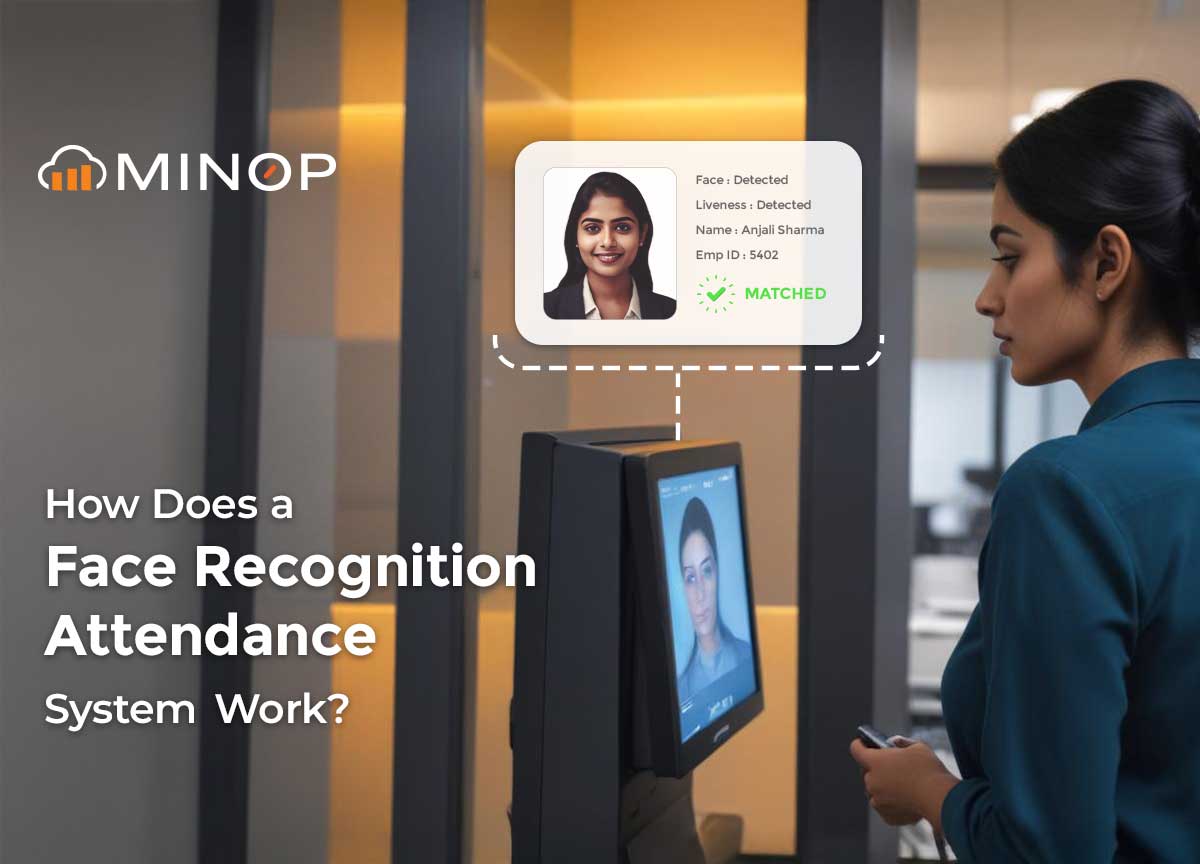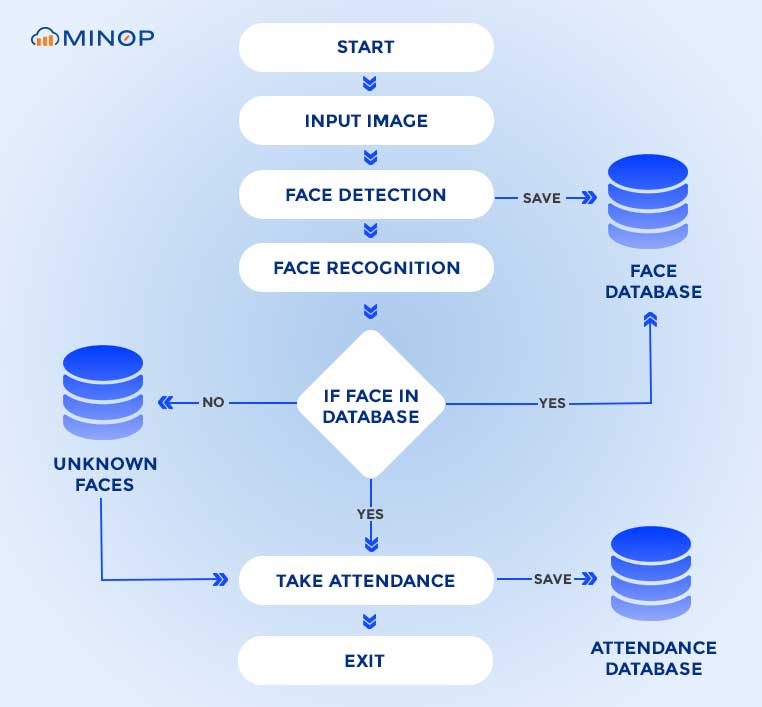How Does A Face Recognition Attendance System Work?
Posted On:- 18 February, 2025 By:- Vaibhav Maniyar
Unlike fingerprint, card punch-in, and system login authentication, facial recognition authentication is far more linear and transparent, offering swift confirmation and accurate results. A face recognition attendance system streamlines HR's work through time-keeping and even automates payroll with flexible add-ons. In this blog, let's explore the architecture of a face recognition attendance system.
We'll also see how Minop's app sets the standard by integrating biometric technology with time and attendance for optimal results. But first, let's start with time and attendance systems.
The Advent Of The Time And Attendance System
Earlier, tracking employee clock-ins, overtime, and leave relied entirely on physical spreadsheets. Each employee had to manually fill out a sheet and submit it at the end of the month. This process was time-consuming and full of loopholes when a supervisor started to confirm the data manually.
With the rise of cloud technology and web applications, attendance tracking is witnessing an AI revolution. The hassle of questioning an employee's productivity or manually verifying records presents a picture of legacy systems currently overtaken by a horde of applications gaining complete control over a company's time and attendance architecture.
With an influx of cutting-edge features paving the way for new applications each year, these systems also play a key role in leave and overtime management. With the introduction of face recognition technology, attendance tracking has become even more secure, accurate, and effortless.
These faces are captured before the tests, allowing the system to recognise them with a pre-existing database. A popular use case is marking attendance upon successful recognition.
Components Of A Face Recognition Attendance System
Being the basic building block, the developer kit acts as the core processing unit for facial recognition, as it has to support multiple camera feeds for real-time processing. The better the developer kit is, the easier it will be for the system to effectively recognise and run deep learning algorithms for complex computer vision tasks.
HD Camera for capturing high-resolution facial images for processing
Storage Space for storing face recognition models, images and attendance logs
Standard issue software development kit for AI applications
NumPy and Pandas Libraries for solving complex matrix calculations for facial feature extraction and processing attendance logs in an Excel sheet format.
Open Source Computer Vision Library for storing built-in algorithms like Haar Cascade (an algorithm that can detect objects in images, irrespective of their scale in image and location) and Local Binary Pattern Histogram (a texture descriptor and face recognition algorithm that uses binary numbers to represent an image) for facial feature extraction
How Face Recognition Works In Attendance System?

When a person stands before the camera, the system captures and preprocesses it by applying grayscale conversion and noise reduction. Then, the Haar Cascade Classifier detects eyes, nose, and mouth and converts it into a histogram representation with the help of the Local Binary Pattern Histogram algorithm.
Furthermore, the face recognition attendance system matches this histogram with pre-stored face data saved in an XML file. This is where the identification starts by comparing similar-looking facial features with the latest preprocessed image of the person.
The system marks attendance if a match is found and logs the time of clock-in, which can be later seen on the Excel file, making the process seamless and efficient. One can even generate reports via email using a pre-configured automated script.
Note: The face recognition attendance system works well in different lighting conditions but gives the best results in well-lit environments. So whenever a new employee or staff member's face is entered into the system, it is not advised to have a slightly turned face with extreme head tilts in very poor lighting. Despite these limits, the system remains a fast, accurate, and efficient way to track attendance automatically.
How Did The Face Recognition Attendance System Evolve?
Once considered a concept from science fiction, biometric face recognition is now essential to human resource management, especially in time and attendance tracking.
While accuracy improved over time, facial measurements and landmark locations still had to be manually calculated in the 1970s. It wasn't until the late 1980s that face recognition software, in which fewer than one hundred data points were needed to encode a standardised facial image accurately, became a viable biometric tool for businesses, leading to the first instances of automated facial recognition.
Today, businesses and institutions use AI-powered facial recognition with features like real-time detection, automatic data logging, and cloud access to simplify workforce management, prevent fraud, and boost security.
The Benefits Of Adding Face Recognition Security
Security is vital for businesses that protect themselves against malicious attacks by intruders and hackers. Currently, most businesses adopting these types of measures could see substantial savings along with other benefits listed below.
Employee Accountability
A Face ID can easily track down any individual who forgets to report to work, forgets to log out, or leaves early. Its ability to monitor employees 24/7 gives employees information about who is in the building at any given time.
Controlling Access To Workplaces
Stopping outside members from entering the workplace without verification is the first step towards a safer working environment. A unique aspect here is verifying people who they are by their facial features, which adds another level of security. Access can be adjusted to prevent certain individuals from entering certain organisational places.
There's no need to distribute special badges or cards - update the software's backend, and you're all set. If an intruder enters the premises, the system issues an alert, which prompts staff to investigate, alerting the relevant authorities.
Reduce Issues With Payroll
A typical hierarchy for a payroll involves at least three people - the manager, an HR or third-party vendor, and the employees themselves. Any potential error these three people make can result in both the loss of time and money. If left unnoticed, the missing payment will only become apparent when the employee receives their paycheck.
This can also affect other important areas, such as pension contributions, tax deductions, and access to benefits. Fixing these errors isn't just time-consuming; it's also costly. Payroll corrections, recalculations, and reissuing paychecks add extra work, while repeated mistakes can hurt employee morale and motivation.
A face recognition attendance system eliminates these risks by directly transferring data from the clock-in station to payroll processing.
Our Commitment
As a leader in biometric research, Mantratec's Minop has developed advanced technologies for face, iris, and fingerprint recognition. With the help of AI and data analytics, Minop improves security and helps businesses make quick and effective decisions in real-time or after an event.
Minop's face recognition API can process multiple camera feeds and scan thousands of faces per minute. This makes it a powerful tool for solving even the toughest security challenges with high speed, accuracy, and reliability. Discover the benefits of Minop's online time and attendance solutions today.

Comments